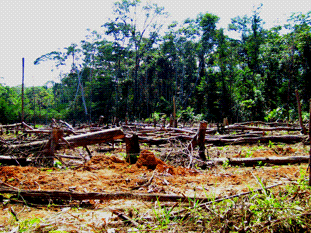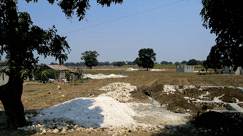Land use and hence land policies are intimately linked to the greatest challenges of this century : the global warming cause, feeding 9 billion inhabitants by 2050, meeting energy needs, maintaining biodiversity, assuring the quality of natural resources such as water, and fulfilling infrastructure and housing needs.
Even now, before the 2050 levels cited by the Kyoto Protocol are reached (450 ppm of CO2 in the atmosphere), the risk presented by global warming is considerable : the greater the rise in temperature, the more the planet’s capacity to absorb carbon gas diminishes, thus sending the warming process into an infernal spiral. Fighting against global warming boils down to reaching the equilibrium between greenhouse gas emissions and their capture as soon as possible. In 2006, 7.2 gigatons of carbon gas were emitted whereas the planet absorbs only about three. As far as C02 is concerned, we must not wait neither until 2050 nor until we reach 450 ppm.
As land plays an essential role in the carbon cycle, its management is necessary in order to combat global warming. On a planetary scale, land stocks an estimated three times more carbon than the atmosphere and four times more than plant biomass. However, global warming reduces this stocking capacity, since organic matter decomposes more quickly in the soil as forests and prairies make way for farmland and urban sprawl.
 In addition, humans’ food needs are increasing as the population grows and as the need to improve the diets of undernourished or malnourished populations develops : 1.5 billion more hectares of arable land are needed. Notably, this land will rise from the ashes of Amazonian and African forests. According to certain energy scenarios, bioenergy needs could increase to over two billion hectares. Forest carbon wells could take up one to two billion more hectares of forests. Aims to conserve biodiversity, flora and fauna, and water quality ought to lead to the ecosystem protection of over billions of hectares. Biofuels and other “biomaterial” petrol substitutes could summon hundreds of thousands of hectares. In addition, in line with the ways in which cities have been expanding over the past decades, urban and infrastructure construction could sprawl upon more than 360,000 hectares before 2050, often competing with the planet’s best farmlands.
In addition, humans’ food needs are increasing as the population grows and as the need to improve the diets of undernourished or malnourished populations develops : 1.5 billion more hectares of arable land are needed. Notably, this land will rise from the ashes of Amazonian and African forests. According to certain energy scenarios, bioenergy needs could increase to over two billion hectares. Forest carbon wells could take up one to two billion more hectares of forests. Aims to conserve biodiversity, flora and fauna, and water quality ought to lead to the ecosystem protection of over billions of hectares. Biofuels and other “biomaterial” petrol substitutes could summon hundreds of thousands of hectares. In addition, in line with the ways in which cities have been expanding over the past decades, urban and infrastructure construction could sprawl upon more than 360,000 hectares before 2050, often competing with the planet’s best farmlands.
 On a global scale, food supply, biofuels, biodiversity, water conservation, and urbanization are now hotly competing for a bit less than nine billion hectares of earth that supports plant growth (1.5 billion hectares of arable land, three billion hectares of natural prairies, and four billion hectares of forests). The above-mentioned supplementary land-use needs are, in some way, prolongations of our modes of production and consumption, which must be reconsidered immediately.
On a global scale, food supply, biofuels, biodiversity, water conservation, and urbanization are now hotly competing for a bit less than nine billion hectares of earth that supports plant growth (1.5 billion hectares of arable land, three billion hectares of natural prairies, and four billion hectares of forests). The above-mentioned supplementary land-use needs are, in some way, prolongations of our modes of production and consumption, which must be reconsidered immediately.
The planet is fragile and finite. Given the current worldwide challenges, land questions are becoming matters of global worry. Land that can support plant growth and thereby capture solar energy and stock carbon is turning out to be a rare and non-renewable resource that needs to be respected as much as water and air. Suitable responses in France and in Europe involve the following : reconstructing the city upon the city, minimizing urban sprawl while directing urban growth onto lands that are less valuable from an agronomic and ecologic point of view, and designing policies that compensate ecological potential (usable water reserves, drainage criteria, ability to house biotopes).
This text is a summary of an article by Robert Levesque, published in Chambres d’agriculture May 2007, N° 963. The full text in French can be downloaded below. We would like to thank the Agricultural Chambers’ review for authorizing us to publish it online.
Robert Levesque is a member of AGTER. He is the director of Terres d’Europe SCAFR.
Translation : Mary Rodeghier.
